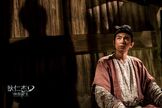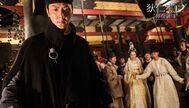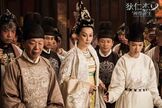1. Tsui Hark and his friends
Compared with "Di Renjie: Tongtian Empire", the most eye-catching thing about "Dragon King of Shendu" is the youth of the cast. Although Angelababy's Luoyang oiran is not in Tang Dynasty style, her amorous feelings are the style of a Chinese ghost girl trained by Old Monster Xu. The screen is filled with poems, and even her foreign-style facial features seem to show some greatness. Tang's Hu Feng.
Di Renjie played by Zhao Youting is elegant and wise, Yuchi played by Feng Shaofeng is arrogant and fierce, Sha Tuozhong played by Lin Gengxin is sensitive and insensitive, and the iron triangle formed by the three friends has a vague taste of Fang Hongye, Yan Chixia and Ning Caichen. And everyone's image is refreshing. Tsui Hark likes to use young actors and is good at giving idol stars a new image style, which has not changed so far.
Of course, the most surprising thing is the imperial physician Wang Pu played by Chen Kun, whose sloppy appearance is actually slightly different from the stunning appearance of "hermaphrodite" in "Flying Swords of Dragon Gate". "Factory Flower" is probably the same as Tsui Hark, there is also an urchin in his heart, right? Sheng Jian, the sharp-edged "Second Gear Head" in "Flying Swords of Dragon Gate", this time, he did the Tang emperor properly.
As we all know, a stable production team is a powerful guarantee for a director's style. Since Tsui Hark went north to develop, his works have been subject to many others. One of the main reasons is that he did not have the support of the stable production team in the 1980s and 1990s. In this "Dragon King of the Gods", the cast is a combination of old and new, and the behind-the-scenes lineup is also extraordinary. Kenji Kawai and Hu Weili create the music, and Yuan Bin serves as the action director, all of whom have worked with Tsui Hark many times in the industry. strong. By the side of this eccentric, a journey of film elites with both experience and vitality has been assembled again.
The theme of the film "Dragon King of Shendu" also holds the pulse of young people. In the first part, Di Renjie bowed down at the feet of the queen, which attracted some boos, but this time the prequel shows how the clear stream represented by the young Di Renjie swept away the officialdom. vibrate.
2. New style - "Full"
Tsui Hark's works have always been known as "fast" in the film industry, which not only refers to his high output and many works, but also refers to the stormy and fast pace of his films, and the plots are ever-changing , the action scenes are edited from countless short shots that are so detailed and suffocating, bringing a dazzling sense of satisfaction to the audience in front of the screen. But what few people have noticed is that after Tsui Hark entered the IMAX 3D era, this style is changing significantly. The style of "Dragon King of Shendu" can no longer be summed up as "fast", but should be "full".
If we take a closer look at the action scenes of "Flying Arms of Dragon Gate", we will find that the number of shots is much less than that of previous Tsui Hark works, and also less than Hollywood works such as "Superman: Man of Steel", which is also an IMAX 3D work. This is obviously a The adjustment made by Tsui Hark considering the visual impact of the super large screen. For the new screen that is full of details, too finely edited may make people dizzy, and slowing down the rhythm to show the details is another option. So we see that the action scenes of the two IMAX 3D works "Dragon Gate Flying Armor" and "Dragon King of Shendu" have a new expression method. One is to superimpose the action in the same picture, such as Zhao Huaian's fist attack and Yuchi's The real gold dodges, and the second is to use a large number of small computer CG images such as sword winds, hidden weapons, and fragments to fill the entire screen. The combination of the two results in a combination of dynamic and static, and a meticulous "full screen" effect.
Another way to make up for the visual gap caused by slowing down is to emphasize the contrast of size. In almost every shot of "Dragon King of Shendu", there are huge buildings and objects filling the picture, and they are often covered with fine lines, giving people a sense of A realistic visual stimulus.
A typical passage is the scene of Yuchi Zhenjin chasing the traitor. In addition to the bombardment of hidden weapons, tiles, and flying hammers, several huge lanterns are also used to fill the picture.
If Tsui Hark's works in the wide-screen era can be summed up as "fast", then Tsui Hark's works entering the IMAX 3D era obviously replace the "fast" in editing with "full" in space, but in any case Time is still space. Tsui Hark's intention to fill the audience's field of vision in every second of viewing time has never changed. "Dragon King of Shendu" represents his latest attempt. Of course, the unprecedented design of hidden weapons flying all over the sky has been criticized by some people as "throwing things into the audience's face crazily", indicating that his experimental method needs further improvement.
The above are the action scenes. In terms of the plot, Tsui Hark has restored the style of winning with "fast" in the golden age. The rhythm is so fast that people have no time to think about the loopholes in the plot. Somersault all the way, don't know what the monkey is knocking on the door. So much so that it is necessary to place an idle corner beside them to ask the audience clearly: "Sir, why are we here?" and "Sir, how do you know they are here?"
3. Monsters, bugs and subculture
Tsui Hark He is famous for his love of playing with monsters, such as the old monster of Montenegro, the thousand-year-old green snake, the flying centipede... Even in a comedy like "Full Banquet of Man and Han", a big fish is designed to appear. In "Empire of Tongtian", he put down his body and played the little bug "Red Flame Beetle", which was obviously the idea of the producer Chen Guofu. This time, "Dragon King of Shendu" specializes in underwater 3D, and he finally let go of his hands and feet and made a good show of the king of fish fighting the navy of the Tang Dynasty. Although there are some flaws in the combination of CG images and real scenes, the unbridled imagination cannot help but remind people of the magical images in "Zhuangzi" and "Shan Hai Jing" that have attracted thousands of generations of Chinese people. Coupled with the dazzling sketches of wonders in the easter eggs at the end of the film, the ambition of the "Di Renjie" series is really fascinating.
Takeda Masaya, who studies fantasy literature in the late Qing Dynasty, once wrote a book called "Fly, the Great Qing Empire". Seeing the magnificent ancient Chinese fantasy blooming on the screen, it is estimated that many audiences also echoed "Fly, the Tang Dynasty". Empire".
In addition to monsters and Gu insects, "Dragon King of Shendu" also shows other ancient subcultures. The first episode focuses on Buddhism and Nestorianism. This episode mainly shows the landscape of Taoism and Zoroastrianism. The last shot of the film ends with an Arab-style dome building, showing the inclusive and prosperous mind of the capital of the Tang Dynasty.
Producer Chen Guofu said that one of the highlights of Di Renjie's series is the various mysterious subcultures in ancient times. Judging from the achievements of the first two films, we have reason to expect Di Renjie and his friends to continue to wander in the mysterious world of ancient China. Complete their unfinished adventure.
ps. Sina manuscript, so the face of the old monster NC fan needs to be slightly restrained. See the original address: http://ent.sina.com.cn/f/m/filmreport6/
View more about Young Detective Dee: Rise of the Sea Dragon reviews











